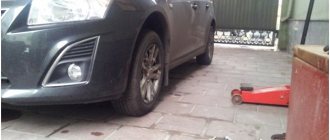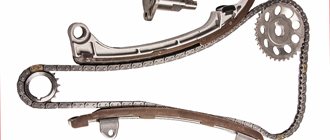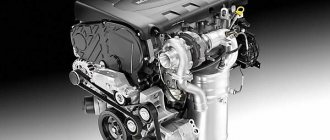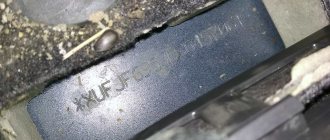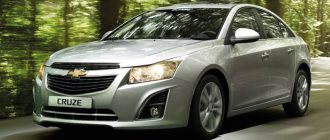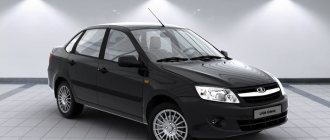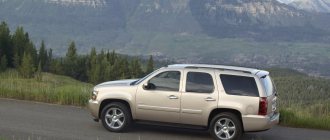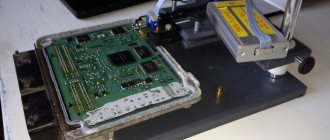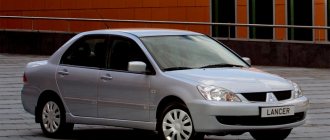Model specifications
Like the rest of the Cruze line, the station wagon is built on the global “GM Delta II” platform and has the following design features:
- transverse arrangement of the motor;
- front-wheel drive;
- independent wishbone-spring front suspension (MacPherson strut);
- semi-independent rear suspension with trailing arms and elastic transverse beam.
GM paid the most serious attention to the safety of the station wagon: tests of the Chevrolet Cruze using Euro NCAP methods brought it the highest score (5 stars).
In terms of carbon dioxide emissions, the Cruze Wagon complies with Euro 5 environmental standards. Sales of the Chevrolet Cruze Wagon (J300 generation) started in 2012; production of the car continued until 2015. In 2021 - 2017, a new generation Chevrolet Cruze appeared, but, unfortunately, the official dealer will not supply this model to the Russian market.
Engines
The Chevrolet Cruze is a unique car. He did not have frankly losing engines, which in no case should be purchased on the secondary market.
All versions are available with three engine options:
- 1.6 liters for 109 “horses”;
- 1.6 liters with 124 horsepower (installed only in a station wagon);
- 1.8 l with a power of 141 hp. With.;
- turbocharged 1.4 liter for 140 liters. With.
The choice of motor depends on your driving style and manner. The 1.6-liter engine is suitable for lovers of measured trips. Acceleration to “hundreds” takes 13 seconds, fuel consumption is 10 liters per 100 km. If you buy it, be prepared for valve cover gasket leaks, frequent ignition coil replacements, and oxygen sensor failures. The timing drive needs to be changed every 60 thousand km. The engine's power reserve is designed for approximately 200 thousand km, which is a decent result for a budget car!
The 1.8-liter engine was subject to a recall campaign due to problems with the fuel system: due to a fuel leak, a fire broke out under the hood. The engine life is designed for 250 thousand km, but after 200 thousand, oil consumption increases sharply, and engine parts begin to gradually break down. A 1.8-liter engine is more expensive to use than a 1.6-liter engine, but fuel consumption is only 8 liters per 100 km. Acceleration to 100 km/h takes 10 seconds.
The turbocharged 1.4-liter unit is more modern, faster and more dynamic than other engines. If you do not take into account the expensive turbine (the cost of a spare part is from 50 thousand rubles), the engine shows itself on the good side. Instead of a timing belt, which needs to be changed every 60 thousand km, the engine is equipped with a chain that is reinstalled at 110 thousand km. But keep in mind, the fast engine was chosen by young people who loved driving fast.
Owners have no questions about manual transmissions; only the weak clutch causes complaints. Manual transmission is chosen by fans of dynamic driving. An automatic transmission is less attractive, since after 100 thousand kilometers the transmission jerks, knocks and kicks, which leads to failure of the valve body. Replacing the gearbox will cost at least 70 thousand rubles.
Also read: Car without tricks: Ford Focus III
Appearance and overall dimensions of the station wagon
The Chevrolet Cruze Wagon has inherited the characteristic features of a sedan and a hatchback: when viewed from the front, the car has a recognizable design, identical bumper, radiator grille and head optics. The smooth silhouette and harmonious shapes of the body panels provide an aerodynamic drag coefficient of within 0.34.
A distinctive feature of the station wagon is its elongated body with an original rear section. Huge taillights, a new bumper, a slightly sloping roof and a spoiler on the tailgate give the station wagon a dignified and noble silhouette. The car has the following dimensions:
- length: 4675 mm;
- width (without mirrors): 1797 mm;
- height: 1484 mm (with roof rails: 1521 mm).
The Cruze Wagon has a curb weight of 1,520 kg and a gross weight of 2,055 kg.
The wheelbase of the station wagon is 2685 mm, and the ground clearance is 145 mm. The car is equipped with R16 wheels with dimensions 205/60 or R17 215/50.
Due to the body shape and increased overhangs, the approach (departure) angle of the Cruze station wagon is limited to only 13 degrees, which requires the driver to be careful when driving outside paved highways. The minimum turning radius is 5.7 m.
Technical characteristics of the Chevrolet Cruze 1.6 sedan
| Body | Four-door sedan |
| Length | 4597 mm |
| Width | 1788 mm |
| Height | 1477 mm |
| Clearance | 140 mm |
| Trunk volume | 450 l |
| engine's type | 4 cylinders, gasoline, injection |
| Engine capacity | 1.6 l |
| Engine power | 109 hp |
| Maximum speed | 180 km/h |
| Curb weight | 1285 kg |
| Acceleration 0-100 km/h | 12.5 sec |
| Fuel consumption | 7.3 l/100 km |
| Years of manufacture | 2008-2015 |
Restyling of the Chevrolet Cruze took place in 2013: a new radiator grille, a reinforced front bumper with fog lights and new optics on standard xenon appeared. Four configuration options have become available:
- Base - the basic one, which was equipped with air conditioning, electric drive and heated side mirrors, an on-board computer, a CD MP3 radio, six-speaker acoustics, electric lifts for the front doors, engine protection and height-adjustable steering wheel with power steering.
- LS - comfort level was additionally equipped with R16 alloy wheels, fog lights, and a central armrest.
- LT - the increased level was equipped with parking sensors, the steering wheel was adjustable for reach and height, power windows were installed on all doors, air conditioning with climate control, side mirrors were with automatic electric drive.
- LTZ - premium included R17 alloy wheels, installation of rain sensors and automatic headlight adjustment, cruise control, a standard head unit with a touch screen, leather upholstery and chrome trim on body and interior elements.
The restyled version of the Cruze after 2013 is equipped with a 1.4-liter turbocharged diesel engine producing 140 hp. with an automatic six-speed gearbox, which also became available for the Russian market. According to reviews from owners, this sedan is considered the best of the entire Chevrolet Cruze line, having excellent dynamics and efficiency: when accelerating to 100 km/h, the figure is 10.2 seconds and fuel consumption on the highway is 5.7 liters per 100 km.
Interior
The station wagon's interior has a typical GM design: a proprietary three-spoke steering wheel with built-in service keys and a wide center console that houses the multimedia system and climate control controls. The steering wheel and front seats have a wide range of adjustments, which helps provide a comfortable fit and good visibility for drivers of any height and build.
It is worth noting that reviews from Chevrolet Cruze owners regarding interior materials and ergonomics have always been positive. The abundance of free space for the driver and passengers deserves special mention:
- ceiling height above the front seats: 999 mm;
- cabin width at shoulder level of front passengers: 1391 mm;
- legroom for front passengers: 1074 mm.
The rear sofa of the station wagon can easily accommodate three large men in winter clothes, and if necessary, it can be folded in the traditional 2/3 proportion, increasing the useful volume for cargo placement.
Trunk options
But station wagons attract buyers not because of their fashionable body paint or elite interior materials - the main indicators of such cars are the capacity and layout of the luggage compartment.
In this category, the Chevrolet Cruze Wagon is ready to compete with any C-class competitors:
| Brand | Load capacity | Trunk volume | Wheelbase | Clearance | |
| standard | maximum | (without load) | |||
| Chevrolet Cruze station wagon | 535 kg | 500 liters | 1478 liters | 2685 mm | 145 mm |
| Kia Sid station wagon | 507 kg | 528 liters | 1642 liters | 2650 mm | 150 mm |
| Ford Focus III station wagon | 518 kg | 476 liters | 1502 liters | 2648 mm | 165 mm |
The depth of the trunk to the back of the rear seats is about 100 cm. The width of the compartment is of a similar size, with a slight narrowing in the area of the wheel arch trim. Some loading restrictions are caused by protrusions in the rear door opening.
A flat floor, without protruding elements or bends, ensures convenient cargo stowage. Shallow side pockets and a hidden compartment in the tailgate can hold tools and accessories without cluttering the main trunk space. To further increase the usable volume, you can attach a luggage box to the car's roof rails.
The top of the luggage compartment is covered with a special curtain, which is a continuation of the rear parcel shelf. The curtain guides move along the rear pillars, so you don't need to fold it completely every time - you can just lift it slightly.
Power unit and transmission Chevrolet Cruze station wagon
The Cruze station wagon is equipped with a standard GM set of four-cylinder internal combustion engines, including two gasoline engines and two diesel options:
| Engine | Power | Maximum torque | Fuel supply system |
| Petrol Ecotec 1.6, F16D4 | 124 hp | 150 Nm | Distributed injection |
| Petrol Ecotec 1.8, F18D4 | 141 hp | 176 Nm | Distributed injection |
| Turbodiesel 1.7, Z17DTR | 130 hp | 300 Nm | Common Rail |
| Turbodiesel 2.0, Z20D1 | 150 hp | 360 Nm | Common Rail |
Unfortunately, diesel station wagons are aimed at European consumers and were not delivered to our country. However, a certain number of Chevrolet Cruze Wagon VDCi still run on Russian roads, so it is quite possible to find a similar car on the secondary car market.
The smaller engines are equipped exclusively with a D16 manual gearbox with a cable-type control drive. For the 1.8 engine and two-liter diesel engine, a choice is available: a five-speed manual or a six-speed automatic of the 6T30/6T40/6T45 modifications.
The manual transmission uses SAE 80W GL-4 or SAE 75W-90 oil; the automatic transmission uses Dexron VI type gear lubricant.
Depending on the installed engine and transmission type, the Chevrolet Cruze Wagon shows the following dynamic characteristics:
| Engine/gearbox | Acceleration to hundreds | Maximum speed | Fuel consumption per 100 km (mixed mode) |
| 1.6 MT | 12.6 sec. | 191 km/h | 6.6 liter AI-95 |
| 1.8 MT | 11.0 sec. | 200 km/h | 6.7 liter AI-95 |
| 1.8 AT | 11.5 sec. | 192 km/h | 7.2 liter AI-95 |
| 1.7 VDCi MT | 10.4 sec. | 200 km/h | 4.5 liter diesel engine |
| 2.0 VDCi MT | 8.8 sec. | 210 km/h | 5.2 liter diesel fuel |
| 2.0 VDCi AT | 9.8 sec. | 205 km/h | 6.3 liter diesel engine |
Technical characteristics of the Chevrolet Cruze
The dimensions of the model allow it to easily maneuver in the city. The length of the hatchback is 4514 mm, width – 1797 mm, height – 1477 mm. The sedan is 83 mm longer, and the station wagon is 167 mm longer.
The trunk volume of the hatchback reaches 413 liters. The sedan has 450 liters of luggage space, and the station wagon has 500 liters. Even the 413-liter compartment is quite enough to transport large suitcases and daily purchases.
Cruze ground clearance is 160 mm. This ground clearance is optimal for the city: you can confidently overcome small potholes and curbs. By the way, the car will feel comfortable on light off-road conditions.
The line of Chevrolet Cruze gasoline engines includes:
- 1.4-liter 140-horsepower units.
- 1.6-liter 109- or 124-horsepower (for station wagons) engines.
- 1.8-liter 141-horsepower units.
Cars are equipped with automatic transmission-6 or manual transmission-5.
Hatchbacks become the leaders in terms of dynamics: variants with a 1.4-liter engine can accelerate to 204 km/h, while reaching the first hundred in 10.5 seconds.
Cruise fuel consumption is from 5 to 5.8 liters per 100 km when driving in mixed mode.
Used Cruze station wagon: purchase and operation
Among car enthusiasts, the Chevrolet Cruze is considered a good car in terms of the combination of price and quality, so it is quite common in the secondary market. The average cost of a used Chevrolet Cruze station wagon with mileage in the range of 60 – 80 thousand as of April 2021 is within the following limits:
- cars produced in 2013: about 520 thousand rubles;
- cars 2014: 550 – 600 thousand rubles;
- station wagons 2015: up to 700 thousand rubles.
Also, do not forget about the associated operating costs, which owners of a used Chevrolet Cruze station wagon should be prepared for:
| Maintenance work | Periodicity | Cost of parts/work |
| Changing the engine oil and oil filter | 15 thousand km | Oil (5 liters) – from 1000 rubles. |
| Oil filter – from 250 rub. | ||
| Adjusting valve clearances on F16D4 / F18D4 | 130 – 150 thousand km | Work – from 1500 rub. |
| Replacing the timing belt on F18D4 | 60 -70 thousand km | Belt and rollers – from 2000 rub. |
| Work – from 2000 rub. | ||
| Replacing the timing chain with VDCi | 200 thousand km | Chain – from 3500 rub. |
| Work – from 5000 rub. | ||
| Changing the automatic transmission oil | 40 thousand km | ATF DEXRON oil – 500 rub/liter |
| Automatic transmission oil filter – from 2500 rubles. | ||
| Work – from 2000 rub. | ||
| Replacing the diesel fuel filter | 60 thousand km | Filter – from 600 rub. |
| Replacing the air conditioning system filter | 15 thousand km | Regular filter - from 400 rubles. |
| Carbon filter – from 700 rub. |
Gasoline engines
The Cruise was equipped with two versions of a gasoline engine, they differed in volume and amount of horsepower. An engine with a larger volume. was equipped with an automatic gearbox, and the smaller volume was equipped with a manual gearbox.
Engine 1.4 liters
The youngest engine in the Cruz family in terms of volume. This internal combustion engine has a small volume, but is equipped with a turbine, which allows you to increase the power of a low-volume engine to serious levels. Such an engine is quite rare on Cruise, but still, you can find it.
Specifications:
| Engine | Volume (l) | Number of drugs | Torque, (Nm) | Number of cylinders | Number of valves | Timing drive | Fuel consumption |
| A14NET | 1,4 | 150 | 200 | 4 | 16 | Belt | 5.9-8.8 |
Result:
A small displacement engine is highly boosted, which significantly reduces its service life. Therefore, finding a live copy with such an engine on the secondary market is almost impossible.
Engine 1.6 liters
This engine is the most popular and is often found on the roads, as it was installed in the basic version of the car with a manual transmission, which was sold in large quantities. Petrol engine with a volume of 1.6 liters and a power of 109 hp. paired with a manual transmission, it has good dynamic characteristics and allows the car to drive well on any road.
Specifications:
| Engine | Volume (l) | Number of drugs | Torque, (Nm) | Number of cylinders | Number of valves | Timing drive | Fuel consumption |
| F16D4 | 1,6 | 109 | 155 | 4 | 16 | Belt | 6,6-7 |
Result:
The engine is quite reliable, but has design flaws. The engine heat exchanger is located close to the exhaust manifold, which causes the gasket to dry out quickly and allow antifreeze to enter the oil, which can lead to engine damage. It is recommended to replace the heat exchanger gasket every 50,000 km.
The timing belt resource on this internal combustion engine reaches 90,000 km. When replacing the timing belt, it is recommended to replace the coolant pump (pump).
Engine 1.8 liters
This internal combustion engine is structurally similar to the 1.6-liter engine and is practically no different from it, with the exception of increased volume and increased power.
Specifications:
| Engine | Volume (l) | Number of drugs | Torque, (Nm) | Number of cylinders | Number of valves | Timing drive | Fuel consumption |
| F18D4 | 1,8 | 141 | 176 | 4 | 16 | Belt | 6,8-8,7 |
Result:
The engine has good technical performance and high reliability. If you change the timing belt and oil in a timely manner, the engine can last up to 500 thousand km without major repairs.
